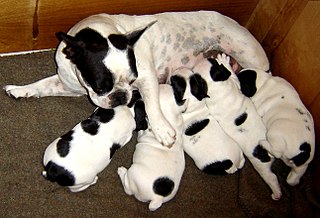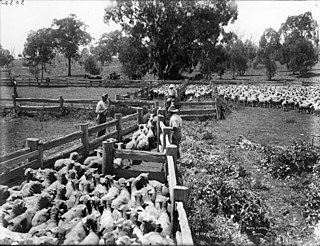Related Research Articles
Biostatistics are the development and application of statistical methods to a wide range of topics in biology. It encompasses the design of biological experiments, the collection and analysis of data from those experiments and the interpretation of the results.

Domestication is a sustained multi-generational relationship in which one group of organisms assumes a significant degree of influence over the reproduction and care of another group to secure a more predictable supply of resources from that second group. The domestication of plants and animals was a major cultural innovation ranked in importance with the conquest of fire, the manufacturing of tools, and the development of verbal language.

Heritability is a statistic used in the fields of breeding and genetics that estimates the degree of variation in a phenotypic trait in a population that is due to genetic variation between individuals in that population. It measures how much of the variation of a trait can be attributed to variation of genetic factors, as opposed to variation of environmental factors. The concept of heritability can be expressed in the form of the following question: "What is the proportion of the variation in a given trait within a population that is not explained by the environment or random chance?"

Selective breeding is the process by which humans use animal breeding and plant breeding to selectively develop particular phenotypic traits (characteristics) by choosing which typically animal or plant males and females will sexually reproduce and have offspring together. Domesticated animals are known as breeds, normally bred by a professional breeder, while domesticated plants are known as varieties, cultigens, cultivars, or breeds. Two purebred animals of different breeds produce a crossbreed, and crossbred plants are called hybrids. Flowers, vegetables and fruit-trees may be bred by amateurs and commercial or non-commercial professionals: major crops are usually the provenance of the professionals.
In animal and plant breeding, truncation selection is a standard method in selective breeding in selecting animals to be bred for the next generation. Animals are ranked by their phenotypic value on some trait such as milk production, and the top percentage is reproduced. The effects of truncation selection for a continuous trait can be modeled by the standard breeder's equation by using heritability and truncated normal distributions; on a binary trait, it can be modeled easily using the liability threshold model. It is considered an easy and efficient method of breeding.

Dog breeding is the practice of mating selected dogs with the intention of maintaining or producing specific qualities and characteristics. When dogs reproduce without such human intervention, their offspring's characteristics are determined by natural selection, while "dog breeding" refers specifically to the artificial selection of dogs, in which dogs are intentionally bred by their owners. Breeding relies on the science of genetics, hence a breeder who is knowledgeable on canine genetics, health, and the intended purpose of the dogs attempts to breed suitable dogs.

Tree breeding is the application of genetic, reproductive biology and economics principles to the genetic improvement and management of forest trees. In contrast to the selective breeding of livestock, arable crops, and horticultural flowers over the last few centuries, the breeding of trees, with the exception of fruit trees, is a relatively recent occurrence.

In biology, culling is the process of segregating organisms from a group according to desired or undesired characteristics. In animal breeding, it is the process of removing or segregating animals from a breeding stock based on specific trait. This is done to exaggerate desirable characteristics, or to remove undesirable characteristics by altering the genetic diversity of the population. For livestock and wildlife, culling often refers to the act of killing removed animals based on their individual characteristics, such as their sex or species membership, or as a means of preventing infectious disease transmission.
Animal breeding is a branch of animal science that addresses the evaluation of the genetic value of livestock. Selecting for breeding animals with superior EBV in growth rate, egg, meat, milk, or wool production, or with other desirable traits has revolutionized livestock production throughout the entire world. The scientific theory of animal breeding incorporates population genetics, quantitative genetics, statistics, and recently molecular genetics and is based on the pioneering work of Sewall Wright, Jay Lush, and Charles Henderson.

The history of model organisms began with the idea that certain organisms can be studied and used to gain knowledge of other organisms or as a control (ideal) for other organisms of the same species. Model organisms offer standards that serve as the authorized basis for comparison of other organisms. Model organisms are made standard by limiting genetic variance, creating, hopefully, this broad applicability to other organisms.
Marker assisted selection or marker aided selection (MAS) is an indirect selection process where a trait of interest is selected based on a marker linked to a trait of interest, rather than on the trait itself. This process has been extensively researched and proposed for plant and animal breeding.
Michel A. J. Georges (1959) is a Belgian biologist and a professor at the University of Liège.
Molecular breeding is the application of molecular biology tools, often in plant breeding and animal breeding. In the broad sense, molecular breeding can be defined as the use of genetic manipulation performed at the level of DNA to improve traits of interest in plants and animals, and it may also include genetic engineering or gene manipulation, molecular marker-assisted selection, and genomic selection. More often, however, molecular breeding implies molecular marker-assisted breeding (MAB) and is defined as the application of molecular biotechnologies, specifically molecular markers, in combination with linkage maps and genomics, to alter and improve plant or animal traits on the basis of genotypic assays.
Professor Jennie Elizabeth Pryce is a quantitative geneticist based in Melbourne, Australia. Jennie is the DairyBio animal program leader in conjunction with her role as principal research scientist for Agriculture Victoria and Professor of animal genetics at La Trobe University.

Michael Edward "Mike" Goddard is a professorial fellow in animal genetics at the University of Melbourne, Australia.

Animal genetic resources for food and agriculture (AnGR) are a subset of genetic resources and a specific element of agricultural biodiversity. The term animal genetic resources refers specifically to the genetic resources of avian and mammalian species, which are used for food and agriculture purposes. Further terms referring to AnGR are "farm animal genetic resources" or "livestock diversity".

In genetics, a polygenic score, also called a polygenic risk score (PRS), genetic risk score, or genome-wide score, is a number that summarises the estimated effect of many genetic variants on an individual's phenotype, typically calculated as a weighted sum of trait-associated alleles. It reflects an individual's estimated genetic predisposition for a given trait and can be used as a predictor for that trait. In other words, it gives an estimate of how likely an individual is to have a given trait only based on genetics, without taking environmental factors into account. Polygenic scores are widely used in animal breeding and plant breeding due to their efficacy in improving livestock breeding and crops.
Lawrence (Larry) Raymond Schaeffer is an American geneticist, and emeritus professor of animal breeding and genetics at the University of Guelph, Guelph, Ontario, Canada.

Daniel Gianola is a geneticist based at the University of Wisconsin-Madison (US), reputed for his contributions in quantitative genetics to the fields of animal and plant breeding. In the early 1980s, Gianola extended best linear unbiased prediction to the non-linear domain for analysis of categorical traits, using the classical threshold model of Sewall Wright. Subsequently, he pioneered the use of Bayesian methodologies and Monte Carlo Markov chain methods in quantitative genetics. He also revived early work by Sewall Wright on structural equation models and cast their application in the context of modern quantitative genetics and statistical methodology. His group in Wisconsin was the first in the world applying non-parametric methods, such as reproducing Kernel Hilbert spaces regression and Bayesian neural networks, to genome-enabled selection in animal breeding, agriculture and whole-genome prediction of complex traits or diseases. Gianola published extensively on thresholds models, Bayesian theory, prediction of complex traits using mixed model methodology, hierarchical Bayesian regression procedures and machine learning techniques. Gianola has been also involved in whole-genome prediction of skin and bladder cancer in humans. He has taught extensively in more than twenty countries including recurrent visiting professorships at the Universidad Politecnica de Valencia (Spain), the Norwegian University of Life Sciences (Norway), Aarhus University (Denmark), Georg-August University (Germany) and the Technical University of Munich (Germany). He has been an Honorary Researcher at the Pasteur Institut de Montevideo since 2016. In an Editorial contained in a volume published in Gianola's honor in the Journal of Animal Breeding and Genetics (2017), it was stated that "He is probably the one lecturer in animal breeding and genetics, who has the biggest impact on the largest number of followers in the numerous classes and courses he has taught with never-ending energy all across the world."
Dr. Rohan L. Fernando is a Professor of Quantitative Genetics in the Department of Animal Science at Iowa State University (ISU), USA. Although recognized for his work in many facets of genetics, Dr. Fernando's efforts have focused primarily on theory and methods for use of genetic markers in breeding, theory and methods for genetic evaluations of crossbred animals, methodology related to the estimation of genetic parameters and the prediction of genetic merit in populations undergoing selection and non-random mating, bayesian methodology for analysis of unbalanced mixed model data, optimization of breeding programs, and use of computer simulation to study dynamics of genetic system.
References
- ↑ Misztal, Ignacy (1999). "Complex Models, More Data: Simpler Programming?". Interbull Bulletin. 20: 33–42.
- ↑ Misztal, I; Tsuruta, S; Strabel, T; Auvray, B; Druet, T; Lee, D H (2002). BLUPF90 and related programs (BGF90). 7th World Congress on Genetics Applied to Livestock Production. Montpellier, France.
- ↑ Aguilar, I; Misztal, I; Tsuruta, S; Legarra, A; Wang, H (2014). PREGSF90 – POSTGSF90: Computational Tools for the Implementation of Single-step Genomic Selection and Genome -wide Association with Ungenotyped Individuals in BLUPF90 Programs (PDF). 10th World Congress of Genetics Applied to Livestock Production. American Society of Animal Science, Champaign, IL.
- ↑ http://nce.ads.uga.edu/software/
- ↑ http://nce.ads.uga.edu/wiki/doku.php?id=start
- ↑ https://famuvie.github.io/breedR/